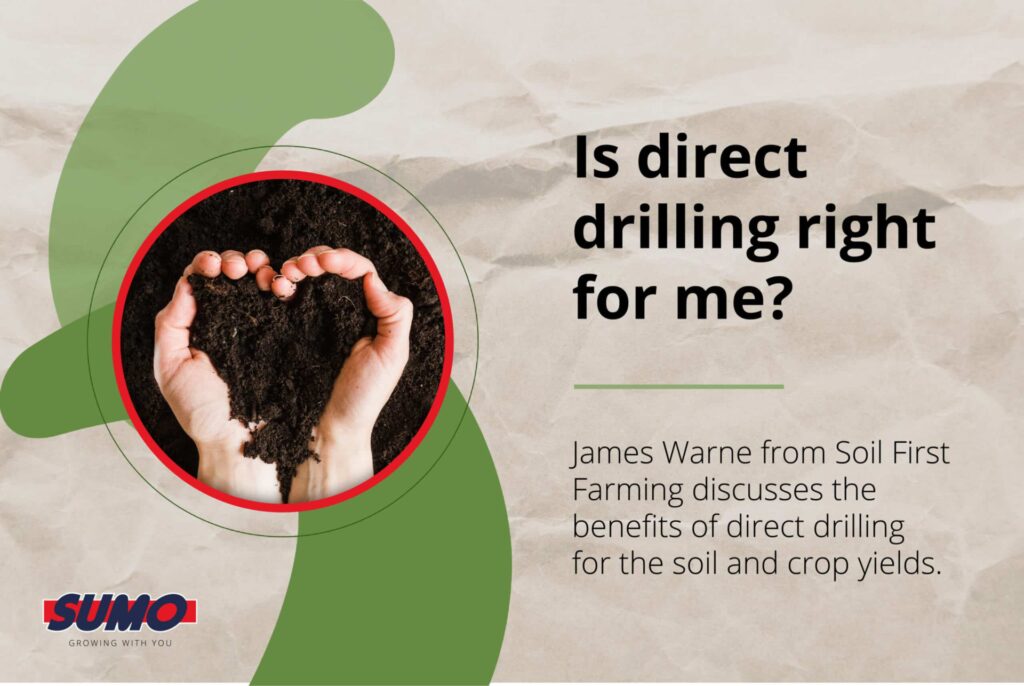Is Direct Drilling right for me?
August 8th, 2022
Direct drilling is a practice which is becoming much more popular in UK agriculture. It is considered by many to be better for the environment and soils as it involves drilling straight into the seedbed with little tillage or disturbance to the soil.
Direct drilling can have multiple benefits for farmers including bringing down costs as well as maintaining crop yields. However, it can be quite a step change if farmers are used to ploughing prior to drilling.
In this blog, James Warne from Soil First Farming explains how direct drilling can benefit soils and crop yields, as well as which kind of farmers will benefit from direct drilling.
How does direct drilling benefit soils?
Soil health is one of the most important influences on crop production, but soils can be incredibly complex to manage.
In order to protect the health of soils, it’s important to consider the benefits direct drilling can have for soil health such as building up soil carbon, increasing earthworm populations and soil fungi.
Building up soil carbon
Carbon is an integral part of soil ecosystems but a number of practices in agriculture such as tillage and artificial fertilisers reduce the level of carbon within the soil profile.
Intense ploughing turns the soil and allows carbon stores to be released whereas artificial nitrogen from fertilisers can oxidise carbon, further reducing levels within the soil. By stopping the movement of soil and direct drilling, the soil biology is allowed to replenish and proliferate, and this will have knock on benefits for crops.
Alongside direct drilling, growing cover crops and returning crop residues to the soil can help to sequester carbon back into the soil.
Increasing earthworm populations
Direct drilling also helps to improve the health of soils by encouraging the growth of earthworm populations. Earthworms are important for soils as they help to mix organic matter throughout the soil profile.
James explains that farmers who direct drill often see earthworm populations increase over the course of five years in their fields. Although this is often a slow recovery, after five years there is often an exponential growth of earthworms which help to benefit the soils.
Increasing soil fungi
Soil fungi are another important aspect of soil ecosystems as they can help to bind nutrients within the soil profile.
However, soil fungi, are easily disturbed and don’t like to be chopped up, turned over and moved. Biological analyses have shown that in cultivated soils, soil fungi levels are often reduced and there is significant bacterial dominance, signifying soils are likely in poor health.
However, in direct drilled soils, studies show that there tends to be a better balance between levels of fungi and bacteria indicating the soil is in better health.
Soil aggregation
Improvements to soil aggregation are also seen in direct drilled soils. Many farmers who direct drill note that after a significant rainfall event, water doesn’t pond on the field surface.
This is because there is much better drainage on direct drilled soils, allowing natural connectivity throughout soil profile. To find out more about improving soil health, visit our blog page.
Which type of farm is direct drilling most suitable for?
James explains that anyone can get into direct drilling. He has seen farmers who grow crops on ‘undesirable’ soils, farm at high altitudes, are located in the north, or in areas of heavy rainfall all succeed with direct drilling. It is particularly suitable for cereal growers looking to reduce inputs, bring down costs and take a more regenerative approach to farming.
Direct drilling may not be as suitable for people who have root crops in their rotation as the soil needs to be moved much more for successful production.
Why should farmers consider direct drilling?
With agricultural subsidies significantly changing as BPS are phased out and ELMs coming in, its important for farmers to look at ways in which they can make their systems more sustainable.
Direct drilling is a much more economic method of farming, which will be important for many to help bring down costs.
Direct drilling can be a practical way for farmers to meet the requirements for new subsidies. James explains that many of the farmers he works with, who direct drill are already meeting the Sustainable Farming Incentive, for example, so don’t have to worry too much about how they’re going to meet the new schemes.
James’ top tips for direct drilling
For farmers looking to start direct drilling, James has some top tips:
- Tip 1: Select your drilling date carefully – it is important to be flexible when it comes to direct drilling, but timing can also be influential for crop establishment and preventing disease. For example, drilling later in September can help to deter pests. Identify what you want to achieve and pick a drilling date carefully to suit.
- Tip 2: Do not expect instant results – If you are looking to improve soil health through direct drilling, be patient, as this is often a long process and can take a few years to improve.
- Tip 3: Work closely with your agronomist – particularly in the early stages of direct drilling as they will be able to advise on how best to introduce the practice.
For more advice about how direct drilling can help you navigate ELMs, speak to your agronomist.



